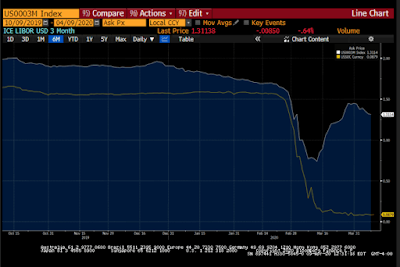Before the weekend, China reported a surge in lending in March. Aggregate social financing, which includes both the formal banking system and shadow-banking (non-bank financial institutions), jumped by CNY5.15 trillion (~$732 bln). This time series is short (~ three years), but it could be a record increase. It also may have been flattered by some activity in February that missed the data collection cut-off. Banks accounted for about 55% or CNY2.85 trillion. In addition to the dramatic rise in lending, Chinese corporations issued around CNY1 trillion bonds, and the government sold roughly CNY635 bln in bonds as well.
China's policy response is not over. News that price pressures are subsiding (March CPI 4.3% year-over-year after 5.2% in February and at 1.2% core inflation is near the lowest level since 2011). More rate cuts are likely, including the Loan Prime Rate, which was inexplicable unchanged in March at 4.05%. When it is set on April 20, a 20 bp cut is expected. Talk of a significant fiscal effort continues to swirl. Officials appear to be assessing the magnitude of the damage as the economy re-starts. The reformist wing of the Chinese Communist Party wants to take advantage of the situation to re-structure and liberalize (i.e. more rather than less market) when and where possible.
 The Federal Reserve's commercial paper facility is scheduled to be launched on April 14. The commercial paper facility is one of several (9) of its kind the Fed has established. They are special-purpose-vehicles (financial jargon for a special type of arm-length entity that can do what the Fed cannot), and it is backed by the US Treasury funding, for which the recent spending bill earmarked $454 bln. The funding is to absorb any losses from the operations.
The Federal Reserve's commercial paper facility is scheduled to be launched on April 14. The commercial paper facility is one of several (9) of its kind the Fed has established. They are special-purpose-vehicles (financial jargon for a special type of arm-length entity that can do what the Fed cannot), and it is backed by the US Treasury funding, for which the recent spending bill earmarked $454 bln. The funding is to absorb any losses from the operations. Opinions expressed are solely of the author’s, based on current market conditions, and are subject to change without notice. These opinions are not intended to predict or guarantee the future performance of any currencies or markets. This material is for informational purposes only and should not be construed as research or as investment, legal or tax advice, nor should it be considered information sufficient upon which to base an investment decision. Further, this communication should not be deemed as a recommendation to invest or not to invest in any country or to undertake any specific position or transaction in any currency. There are risks associated with foreign currency investing, including but not limited to the use of leverage, which may accelerate the velocity of potential losses. Foreign currencies are subject to rapid price fluctuations due to adverse political, social and economic developments. These risks are greater for currencies in emerging markets than for those in more developed countries. Foreign currency transactions may not be suitable for all investors, depending on their financial sophistication and investment objectives. You should seek the services of an appropriate professional in connection with such matters. The information contained herein has been obtained from sources believed to be reliable, but is not necessarily complete in its accuracy and cannot be guaranteed.
Recommended Content
Editors’ Picks
EUR/USD edges lower toward 1.0700 post-US PCE

EUR/USD stays under modest bearish pressure but manages to hold above 1.0700 in the American session on Friday. The US Dollar (USD) gathers strength against its rivals after the stronger-than-forecast PCE inflation data, not allowing the pair to gain traction.
GBP/USD retreats to 1.2500 on renewed USD strength

GBP/USD lost its traction and turned negative on the day near 1.2500. Following the stronger-than-expected PCE inflation readings from the US, the USD stays resilient and makes it difficult for the pair to gather recovery momentum.
Gold struggles to hold above $2,350 following US inflation

Gold turned south and declined toward $2,340, erasing a large portion of its daily gains, as the USD benefited from PCE inflation data. The benchmark 10-year US yield, however, stays in negative territory and helps XAU/USD limit its losses.
Bitcoin Weekly Forecast: BTC’s next breakout could propel it to $80,000 Premium

Bitcoin’s recent price consolidation could be nearing its end as technical indicators and on-chain metrics suggest a potential upward breakout. However, this move would not be straightforward and could punish impatient investors.
Week ahead – Hawkish risk as Fed and NFP on tap, Eurozone data eyed too

Fed meets on Wednesday as US inflation stays elevated. Will Friday’s jobs report bring relief or more angst for the markets? Eurozone flash GDP and CPI numbers in focus for the Euro.